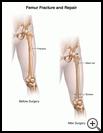
Thighbone (Femur Shaft) Fracture
What is a thighbone fracture?
A thighbone fracture is a break or crack in the bone of your upper leg. This bone is called the femur. The break may be just a bend or small crack in the bone, or the bone may break into pieces or shatter. Some fractures may stick out through the skin.
Thighbone fractures are more likely to happen if you:
- Fall from a high place
- Are in a high-speed collision, such as a car, ski, or snowmobile accident
- Have a medical condition that causes weak or brittle bones
- Take medicine that weakens bones
What can I expect in the hospital?
You may need to stay in the hospital because you need close monitoring, surgery, or other treatment to treat your thighbone fracture.
Several things may be done while you are in the hospital to monitor, test, and treat your condition. They include:
Monitoring
- You will be checked often by the hospital staff.
- Your heart rate, blood pressure, and temperature will be checked regularly.
Testing
Testing may include:
- Blood tests to check for infections or blood loss
- X-rays: Pictures of the inside of the leg to check for a fracture
- Computed tomography (CT) scan: A series of X-rays is taken from different angles and arranged by a computer to show thin cross sections of the bones in the leg.
- Magnetic resonance imaging (MRI): A powerful magnetic field and radio waves are used to take pictures from different angles to show thin cross sections of the bone.
- Bone scan: A series of detailed pictures are taken after your healthcare provider injects a small amount of radioactive material into your blood. The scan shows any areas of bone where the radioactive material is being absorbed.
Treatment
The treatment for a thighbone fracture depends on where the break is located, how badly broken the bone is, your overall health, and any complications you may have.
- You will have a small tube (IV catheter) inserted into a vein in your hand or arm. This will allow for medicine to be given directly into your blood and to give you fluids, if needed.
- Your provider may put traction on the leg with the thighbone fracture until you have surgery. This involves putting a cloth boot on your foot and lower leg and attaching it to just enough weight to pull your broken bone back into the right position.
- You may need surgery to treat your thighbone fracture. Surgery may include:
- External fixation: Surgery in which pins or screws are put through the skin and into the bone above and below the fracture. A long metal bar is attached to the pins or screws on the outside of the leg to keep the bone in the right place.
- Open reduction and internal fixation (ORIF): Surgery to stabilize the thighbone with pins, rods, screws, or plates
- You will most likely have a cast put on your leg to keep the bones in good position so they heal.
- Your provider may prescribe medicine to:
- Treat pain
- Treat or prevent an infection
- Treat or prevent side effects, such as nausea or constipation, from other treatments
- Prevent blood clots
- Your provider may recommend other types of therapy to help relieve pain, other symptoms, or side effects of treatment.
- You may need physical or occupational therapy to help you recover from your thighbone fracture. Most rehabilitation programs include:
- Physical therapy to help you regain muscle strength and teach you ways to move safely
- Occupational therapy to help you relearn safe ways to do the tasks that you did before your thighbone fracture
What can I do to help?
- You will need to tell your healthcare team if you have new or worsening:
- Pain that is not controlled with your medicines
- Redness, swelling, pain, warmth, or drainage from your surgical wound
- Fever, chills, or muscle aches
- Swelling, numbness, abnormal sensations in your leg, ankle, or foot on the side of your thighbone fracture
- Coldness or change in color of the skin of your leg, ankle, or foot on the side of your thighbone fracture
- Warmth, redness, or pain in your leg
- If you are taking medicine to prevent blood clots, unusual or unexpected bleeding
- If you notice hardware becoming loose or if you injure your leg again while it is healing
- Ask questions about any medicine, treatment, or information that you do not understand.
How long will I be in the hospital?
How long you stay in the hospital depends on many things, such as your general health, why you are in the hospital, and the treatment you need. The average amount of time to stay in the hospital with a thighbone fracture is 3 to 5 days. Talk with your provider about how long your stay may be.
You may need to go to a rehab facility to continue your rehab program before going home.
Last modified: 2015-12-22
Last reviewed: 2015-12-21

